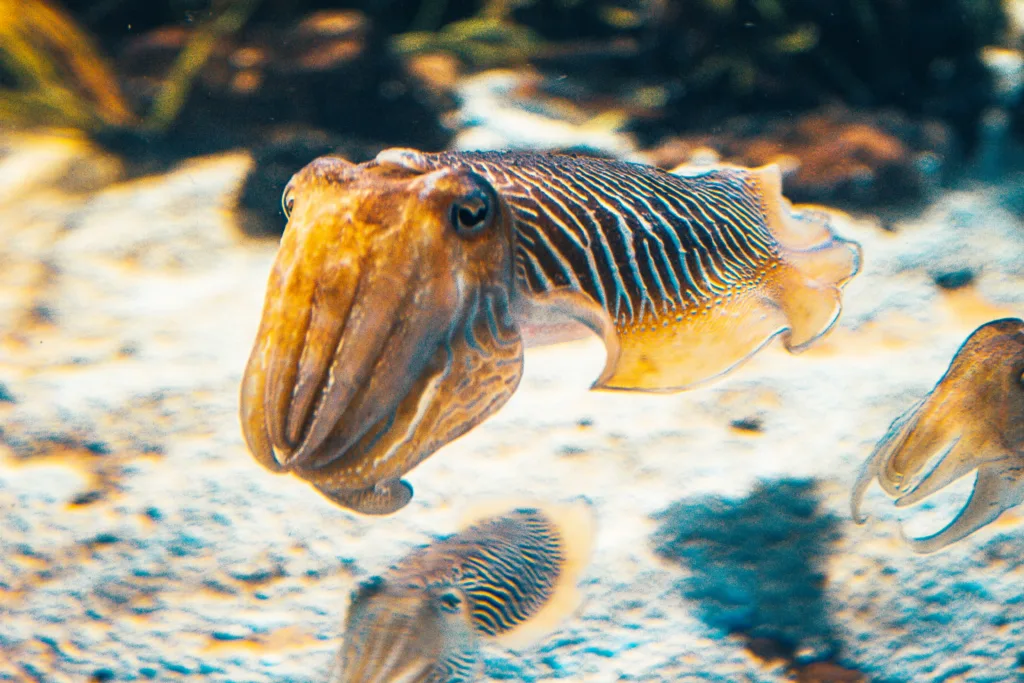Mollusks are a diverse group of invertebrates that include animals like clams, snails, and squid. Despite the differences in their appearance and lifestyle, they all share certan characteristics that define them as mollusks.
One characteristic that all mollusks share is a soft body that is protected by some sort of shell. In some mollusks, like clams and oysters, this shell is external and is made of calcium carbonate. In others, like squid and octopuses, the shell is internal and is called a pen. This pen serves as a support structure for the squid’s body and is made of a tough, flexible material called chitin.
Another trait that is common among mollusks is the presence of a muscular foot that is used for movement. In snails and slugs, this foot is located on the underside of the body and is used for crawling. In squid and octopuses, the foot has evolved into a set of tentacles that are used for grasping and swimming.
Despite these similarities, there are also many differences between different groups of mollusks. For example, clams and oysters are filter feeders that live their lives attached to rocks or other surfaces. Squid and octopuses, on the other hand, are active predators that use their tentacles to capture prey.
The diversity of mollusks is a testament to the incredible adaptability of these animals. Whether they live in the sea or on land, mollusks have evolved a wide range of strategies for survival that have allowed them to thrive in a variety of environments. Whether you’re a scientist studying these amazing creatures, or simply an admirer of their beauty and complexity, there is always something new to learn about the world of mollusks.
What Mollusk Traits Do Squids Have?
Squid are classified as mollusks, which means they share some common traits with othr members of this group, such as clams and oysters. However, squids have some unique characteristics that set them apart from other mollusks. Here are some of the key traits that define squids:
– Lack of external shell: Unlike many other mollusks, squids do not have a protective shell on the outside of their bodies. Instead, they have a small internal shell called a pen that provides some support but does not encase the entire body.
– 10 arms: Squids have a total of 10 arms, which they use for a variety of tasks such as hunting, swimming, and grasping prey. Two of these arms are longer and thinner than the others and are used for capturing food.
– Jet propulsion: Squids are able to move quickly through the water by expelling water out of their mantle cavity through a siphon. This allows them to swim in short bursts and to escape from predators.
– Large eyes: Squids have some of the largest eyes in the animal kingdom in relation to their body size. This is thought to help them navigate in the deep ocean and to spot prey.
– Ink sacs: When threatened, squids are able to release a cloud of dark ink into the water, which can help them escape from predators by obscuring their location.
Squids are fascinating creatures that have evolved unique adaptations to survive in their ocean habitats.

What Are 2 External Features That Are Adaptations For A Squids Predatory Life?
Squids, being carnivorous and predatory animals, have evolved varius external features that help them survive and thrive in their natural habitat. Two notable adaptations are their small hooks and the rings of teeth around their suckers. These hooks are present on the arms and tentacles of squids and help them in capturing and holding onto their prey. The rings of teeth are present around their suckers and are used to grasp and tear apart their prey. These adaptations are essential for a squid’s predatory lifestyle as they enable them to catch and consume their prey more efficiently. Additionally, their streamlined body shape, jet propulsion system, and ability to change color and texture also aid in their hunting and survival.
How Many Gills Does A Squid Have?
A colossal squid has two large gills, each with 20 to 80 gill filaments on either side, which are located in the mantle. These gills serve as the primary respiratory organs of the squid, allowing for the diffusion of oxygen from the water into the blood. The oxygen is then transported to the gill (or branchial) hearts through a network of blood vessels. Therefore, a colossal squid has a total of 40 to 160 gill filaments for the exchange of gases.
How Does A Squid’s Pen Relate To A Clams Shell?
The squid’s pen and the clam’s shell are related in that they are both made of calcium carbonate and serve as protective structures for the animals. The pen, whih is the internal shell of the squid, is a remnant of the ancestral shell that squid and other cephalopods once had. The clam’s shell, on the other hand, is an external structure that is used to protect the soft body of the animal from predators and the environment. While the pen and the clam’s shell may differ in their location and function, they share a common evolutionary history and are part of a larger group of shelled animals known as mollusks.
Conclusion
Mollusks are a diverse and fascinating group of animals that includes clams, oysters, snails, and squids. They are found in a wide range of habitats, from the depths of the ocean to freshwater streams and even on land. One of the most remarkable features of mollusks is their ability to adapt to their surroundings, whether throuh developing shells or specialized arms and tentacles for catching prey. Additionally, mollusks play an important role in the ecosystem, serving as food sources for many other animals and helping to maintain a healthy balance in aquatic environments. the study of mollusks continues to provide valuable insights into the diversity of life on our planet and the complex relationships between different species.
